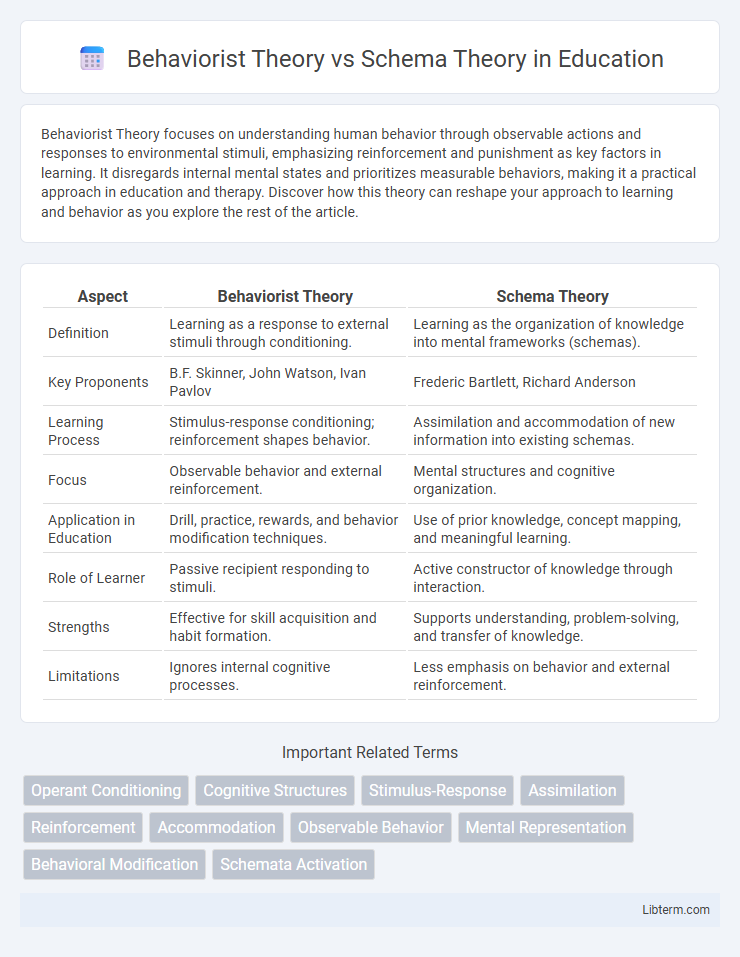Behaviorist Theory focuses on understanding human behavior through observable actions and responses to environmental stimuli, emphasizing reinforcement and punishment as key factors in learning. It disregards internal mental states and prioritizes measurable behaviors, making it a practical approach in education and therapy. Discover how this theory can reshape your approach to learning and behavior as you explore the rest of the article.
Table of Comparison
| Aspect | Behaviorist Theory | Schema Theory |
|---|---|---|
| Definition | Learning as a response to external stimuli through conditioning. | Learning as the organization of knowledge into mental frameworks (schemas). |
| Key Proponents | B.F. Skinner, John Watson, Ivan Pavlov | Frederic Bartlett, Richard Anderson |
| Learning Process | Stimulus-response conditioning; reinforcement shapes behavior. | Assimilation and accommodation of new information into existing schemas. |
| Focus | Observable behavior and external reinforcement. | Mental structures and cognitive organization. |
| Application in Education | Drill, practice, rewards, and behavior modification techniques. | Use of prior knowledge, concept mapping, and meaningful learning. |
| Role of Learner | Passive recipient responding to stimuli. | Active constructor of knowledge through interaction. |
| Strengths | Effective for skill acquisition and habit formation. | Supports understanding, problem-solving, and transfer of knowledge. |
| Limitations | Ignores internal cognitive processes. | Less emphasis on behavior and external reinforcement. |
Introduction to Learning Theories
Behaviorist Theory emphasizes learning as a process of conditioning through reinforcement and punishment, where behaviors are shaped by external stimuli. Schema Theory, in contrast, focuses on internal cognitive structures that organize knowledge and guide the interpretation of new information based on prior experiences. These foundational learning theories provide distinct frameworks for understanding how individuals acquire, process, and retain knowledge in educational settings.
Overview of Behaviorist Theory
Behaviorist Theory emphasizes learning through observable behaviors shaped by environmental stimuli and reinforcement, relying on principles such as classical and operant conditioning. Key figures like B.F. Skinner and John Watson highlight the importance of external factors in modifying behavior without considering internal cognitive processes. This theory forms the foundation for behavior modification techniques used in educational and therapeutic settings.
Key Principles of Schema Theory
Schema Theory emphasizes that knowledge is organized into mental frameworks called schemas, which help individuals interpret and predict information based on prior experience. It highlights the active role of learners in constructing understanding through assimilation and accommodation processes. Unlike Behaviorist Theory, which focuses on observable stimulus-response patterns, Schema Theory prioritizes internal cognitive structures in learning.
Historical Background and Development
Behaviorist Theory, rooted in early 20th-century work by John B. Watson and B.F. Skinner, emphasizes learning through conditioning and external stimuli, marking a shift from introspective methods to observable behavior analysis. Schema Theory emerged in the 1970s through the cognitive revolution, with researchers like Frederic Bartlett and later Jean Piaget focusing on mental frameworks that organize and interpret information. The development of Schema Theory represented a move toward understanding internal cognitive processes, contrasting behaviorism's emphasis on external behavioral change.
Core Differences Between Behaviorist and Schema Theories
Behaviorist Theory centers on observable behaviors and external stimuli, emphasizing learning as a response to reinforcement and punishment, while Schema Theory focuses on internal mental frameworks that organize knowledge and influence information processing. Behaviorism relies on stimulus-response associations without considering cognitive processes, whereas Schema Theory highlights how prior knowledge shapes comprehension and memory. The core difference lies in Behaviorist Theory's external behavioral emphasis versus Schema Theory's internal cognitive structures guiding learning.
Applications in Education and Learning
Behaviorist Theory in education emphasizes rote learning and reinforcement through rewards and punishments, promoting skill acquisition via repetition and practice, ideal for foundational knowledge and behavior modification. Schema Theory enhances comprehension and critical thinking by activating prior knowledge structures, enabling learners to organize and integrate new information effectively in meaningful contexts. Combining these theories supports diverse instructional strategies, including drill-based mastery and concept mapping, which cater to varied cognitive processes involved in learning.
Strengths and Limitations of Behaviorist Theory
Behaviorist Theory excels in emphasizing observable behaviors and measurable outcomes, making it highly effective for structured learning environments and skill acquisition through repetition and reinforcement. Its main limitation is the neglect of internal cognitive processes, ignoring how prior knowledge and mental frameworks influence learning, which Schema Theory addresses by highlighting the role of mental structures in interpreting new information. This narrow focus on external stimuli-response mechanisms restricts Behaviorist Theory's applicability to complex cognitive tasks that require understanding, reasoning, and adaptation.
Strengths and Limitations of Schema Theory
Schema Theory excels in explaining how prior knowledge influences information processing and learning by organizing experiences into mental frameworks, enhancing comprehension and memory. However, its limitations include difficulty in empirically measuring schemas and potential overemphasis on cognitive structures while neglecting emotional and contextual factors. Despite these challenges, Schema Theory offers valuable insights into cognitive development and instructional design by emphasizing the integration of new information with existing knowledge.
Implications for Classroom Practice
Behaviorist Theory emphasizes repetitive drills and reinforcement to shape student behavior, promoting structured lesson plans with clear rewards and consequences to encourage learning. Schema Theory highlights the importance of prior knowledge and mental frameworks, suggesting that teachers activate students' existing schemas through meaningful connections and scaffolding to enhance comprehension. Effective classroom practice integrates behaviorist strategies for skill mastery while leveraging schema activation to deepen understanding and support critical thinking.
Conclusion and Future Directions
Behaviorist Theory emphasizes observable behavior changes through reinforcement and conditioning, whereas Schema Theory highlights the role of mental frameworks in organizing and interpreting information. Future research may integrate these perspectives to develop hybrid models that address both external behavioral patterns and internal cognitive structures. Advancements in neuroimaging and AI could enhance understanding of how behavior and cognitive schemas interact dynamically.
Behaviorist Theory Infographic

 libterm.com
libterm.com